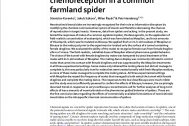Content
Neonicotinoid insecticides are increasingly recognized for their role as information disruptors by modifying the chemical communication system of insects and therefore decreasing the chances of reproduction in target insects. However, data from spiders are lacking. In the present study, we tested the responses of males of a common agrobiont spider, Pardosa agrestis, to the application of field-realistic concentration of acetamiprid, which was formulated as Mospilan, and trace amounts of thiacloprid, which was formulated as Biscaya. We applied fresh or 24-h-old residues of Mospilan or Biscaya to the males just prior to the experiment or treated only the surface of a tunnel containing female draglines. We evaluated the ability of the males to recognize female cues from female dragline silk in a Y-maze. The field-realistic, sublethal doses of Mospilan altered pheromone-guided behavior. The choice of the tunnel with female draglines by males was hampered by tarsal treatment of the males with 24 h-old residues of Mospilan. The mating dance display was commonly initiated in control males that came into contact with female draglines and was suppressed by the Mospilan treatments in all three experimental settings. Some males only initiated the mating dance but did not manage to complete it
this was particularly true for males that were treated tarsally with fresh Mospilan residues, as none of these males managed to complete the mating dance. All three experimental settings with Mospilan decreased the frequency of males that managed to both select the tunnel with female draglines and complete the mating dance. The responses to the low-dose Biscaya were much milder and the study was not sufficiently powered to confirm the effects of Biscaya
however, the surprisingly observed trends in responses to very low Biscaya concentrations call for further analyses of long-term effects of trace amounts of neonicotinoids on the pheromone-guided behavior of spiders. These are the first conclusive data regarding the effects of commercially available formulations of neonicotinoid insecticides on the intraspecific chemical communication of spiders.
this was particularly true for males that were treated tarsally with fresh Mospilan residues, as none of these males managed to complete the mating dance. All three experimental settings with Mospilan decreased the frequency of males that managed to both select the tunnel with female draglines and complete the mating dance. The responses to the low-dose Biscaya were much milder and the study was not sufficiently powered to confirm the effects of Biscaya
however, the surprisingly observed trends in responses to very low Biscaya concentrations call for further analyses of long-term effects of trace amounts of neonicotinoids on the pheromone-guided behavior of spiders. These are the first conclusive data regarding the effects of commercially available formulations of neonicotinoid insecticides on the intraspecific chemical communication of spiders.



